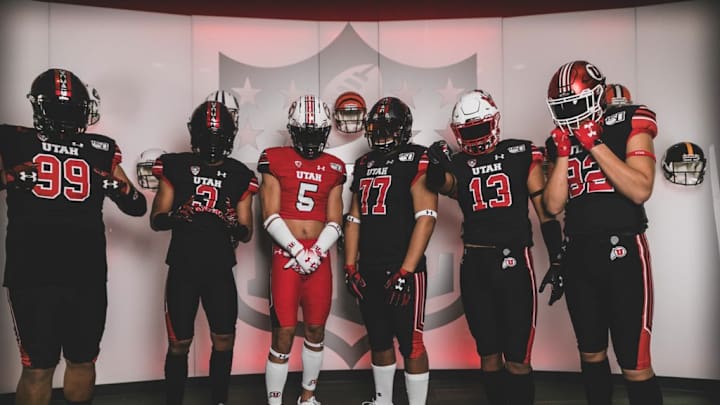Can some 2021 recruits suit up for the Utes for spring football?

It may be the month of August, and the COVID-19 pandemic may be seriously hindering recruiting for most of the college football programs throughout the country. But for the University of Utah, head coach Kyle Whittingham and co. are off to a stellar start in recruiting compared to where they usually are this time of year.
Headlining Utah's 2021 recruiting class is quarterback Peter Costelli, one of the top-ranked passers in the country according SI All American's John Garcia.
Joining Costelli is one of the premier running backs in the country in soon-to-be four-star running back Ricky Parks out of Gaither High School in Tampa, Florida. The Utes the secured their first wide receiver commit of the 2021 class when Deamikkio Nathan, the playmaker out of South Grand Prairie High School in Grand Prairie, Texas, announced his commitment to the Utes on July 1.
All three players have been named SI All-American nominees.
Altogether, the Utes have eight recruits in their 2021 class; Costelli, Parks, Nathan, DT Tevita Fotu, LB Trey Reynolds, OG Koli Faaiu, DE Viliami Pouha and OLB Jonah Eliss.
As of right now, Costelli is the only to-be Ute expected to enroll in classes for January, but reports have circulated that Parks may be joining him as well. And this number doesn't even include the recruits who have yet to commit to the program and may enroll early as well.
According to reports, several mid-year enrollees who are committed to Pac-12 programs are expecting to be eligible to participate in postponed 2020 seasons — many of whom learned of the possibility through the coaches recruiting them.
“We don’t have a definite answer, but everything I’ve heard is we could be eligible. The good thing is it might not count as a year of eligibility,” USC commit Miller Moss said in an interview with SI this week. “It’s super exciting for me to hear. Nothing like it has ever happened before. It’s a unique opportunity. People talk about losing those (high school) game reps as a senior, but you could add game reps at a higher level.”
The NCAA Division I council announced last Wednesday that it was recommending that every fall sports season athlete be granted an extra year of eligibility, REGARDLESS of the amount of competition they compete in during the fall/spring.
Basically, this is a free season for fall athletes and will not count as a season of eligibility. Typically under NCAA rules, four or more football games played counts as a season of eligibility.
The decision isn't final as of yet, as the Board of Governors (the NCAA's governing body) still have to approve of the Council's recommendation.
So for the Utah recruits who plan to enroll early in January, will they be available to participate in the spring season?
The NCAA might dash those hopes. The buzz around this issue has reached one of the highest rule-making committees in NCAA Division I. The Football Oversight Committee explored the situation last week and plans to further examine it during its meeting next week, says West Virginia athletic director Shane Lyons, chair of the Oversight Committee. He personally believes that mid-year arrivals should not be eligible to play a winter or spring season, but he’s not certain what course the committee will choose.
There is strong opposition—especially from those schools still planning to play a fall season—against such an unprecedented ruling. It creates an imbalance among the 10 FBS conferences: the six still working toward a fall season and the four planning to play a season starting in January–March. Is it fair that one group of mid-year freshmen get an extra season? Such a thing could be dangled in recruiting as an inducement to sway prospects. It could be a significant disadvantage for those playing in fall.
“There’s certainly been discussion about eligibility,” says Todd Berry, executive director of the American Football Coaches Association and a member of the Oversight Committee. “Do they get a free year? They are doing it in this academic year. It’s a challenging proposition.”
"The question is, is the interpretation going to apply for mid-year enrollees?” Lyons added. “There is a recruiting disadvantage for those playing (in the fall). You don’t have the opportunity to say ‘You get to play in the spring if you come here. I don’t think that was the intent of the eligibility (change). It’s about those who were already enrolled.”
Normally, mid-year enrollees can participate in bowl or CFP practices in December and January but are not eligible to play in games. Enrolling at the mid year is a hot trend across the college football landscape. Some programs enroll in January upwards of 10 members of their signing class. The move provides freshmen an extra five months to adjust to college life before games begin, giving them the opportunity to train with their new team in winter workouts and spring practice.
Want to share opinions or ask questions? We want to hear them! Making a profile is free and it only takes ~1 minute to set up. Also, be sure to like us on social media for future coverage:
Twitter — @UtahUtes_SI and Ryan Kostecka at @Ryan_Kostecka
